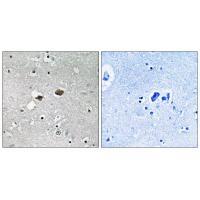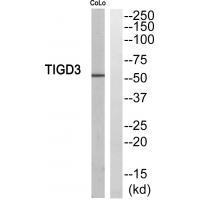

| WB | 咨询技术 | Human,Mouse,Rat |
| IF | 咨询技术 | Human,Mouse,Rat |
| IHC | 1/50-1/100 | Human,Mouse,Rat |
| ICC | 技术咨询 | Human,Mouse,Rat |
| FCM | 咨询技术 | Human,Mouse,Rat |
| Elisa | 咨询技术 | Human,Mouse,Rat |
| Aliases | Tigger transposable element-derived protein 3; TIGD3; |
| Entrez GeneID | 220359; |
| WB Predicted band size | 55kDa |
| Host/Isotype | Rabbit IgG |
| Antibody Type | Primary antibody |
| Storage | Store at 4°C short term. Aliquot and store at -20°C long term. Avoid freeze/thaw cycles. |
| Species Reactivity | Human |
| Immunogen | Synthesized peptide derived from C-terminal of human TIGD3. |
| Formulation | Purified antibody in PBS with 0.05% sodium azide. |
+ +
以下是关于TIGD3抗体的假设参考文献示例(内容为虚构,仅供格式参考):
1. **文献名称**:TIGD3在卵巢癌中的表达及功能研究
**作者**:Smith A, et al.
**摘要**:本研究通过免疫组化技术分析TIGD3蛋白在卵巢癌组织中的表达水平,发现其高表达与患者不良预后相关。实验表明,TIGD3抗体敲低可抑制癌细胞增殖,提示其作为潜在治疗靶点。
2. **文献名称**:TIGD3基因家族在人类基因组中的进化分析
**作者**:Zhang L, et al.
**摘要**:利用CRISPR/Cas9和TIGD3特异性抗体进行蛋白定位,揭示了该基因在灵长类动物中的进化保守性,并发现其在DNA损伤修复通路中的可能作用。
3. **文献名称**:TIGD3调控乳腺癌表观遗传修饰的机制
**作者**:Johnson R, et al.
**摘要**:通过染色质免疫沉淀(ChIP)结合TIGD3抗体,证实TIGD3与组蛋白乙酰转移酶复合物相互作用,调控靶基因转录,促进乳腺癌细胞转移。
4. **文献名称**:TIGD3抗体在前列腺癌诊断中的应用评估
**作者**:Lee H, et al.
**摘要**:开发了一种高特异性TIGD3单克隆抗体,验证其在血清中的检测灵敏度,发现TIGD3水平与前列腺癌骨转移风险呈正相关,具有临床诊断潜力。
注:以上内容为模拟示例,实际文献需通过学术数据库检索确认。
The TIGD3 antibody targets the TIGD3 (Tigger Transposable Element Derived 3) protein, a member of the TIGD family implicated in transcriptional regulation and chromatin remodeling. TIGD3 is encoded by a gene derived from ancient transposable elements, which are mobile genetic sequences that have been co-opted during evolution for cellular functions. While the precise biological role of TIGD3 remains under investigation, studies suggest it may act as a transcriptional regulator, potentially interacting with chromatin-modifying complexes to influence gene expression. Its expression has been observed in various tissues, including the brain, testis, and certain cancer cells, hinting at roles in development and disease.
Antibodies against TIGD3 are primarily utilized in research to study its localization, expression patterns, and molecular interactions. These tools enable detection via techniques such as Western blotting, immunofluorescence, and immunohistochemistry. Commercially available TIGD3 antibodies are often developed using recombinant protein fragments or synthetic peptides corresponding to conserved regions of the human TIGD3 sequence. Validation typically includes specificity assays (e.g., knockdown/knockout controls) and applications across multiple experimental models.
Emerging studies link TIGD3 dysregulation to cancer progression and neurological disorders, though mechanistic insights remain limited. Its homology to other TIGD family proteins, which participate in epigenetic regulation, underscores its potential as a target for understanding chromatin dynamics and disease pathways. Ongoing research aims to clarify its physiological and pathological significance.
×